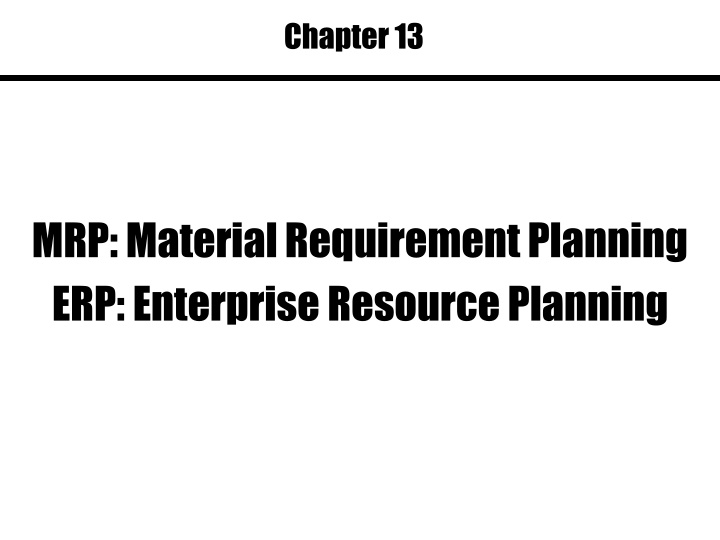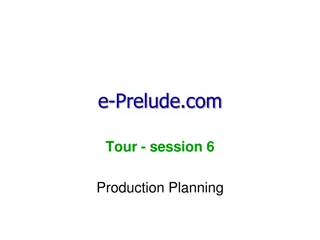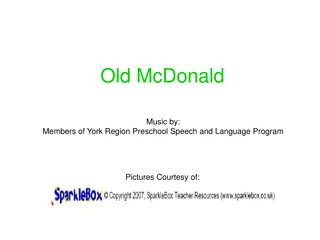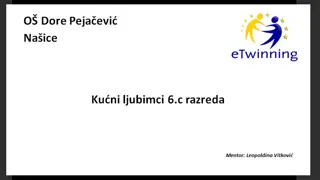
Material Requirement Planning and Enterprise Resource Planning
This information delves into the concepts of Material Requirement Planning (MRP) and Enterprise Resource Planning (ERP), explaining the processes, data flow, and input requirements involved. It covers topics such as independent and dependent demand, product structure trees, and the role of MRP in ordering and scheduling inventories. The content also provides insights into inputs like master schedules and bills of materials, essential for effective MRP implementation.
Download Presentation

Please find below an Image/Link to download the presentation.
The content on the website is provided AS IS for your information and personal use only. It may not be sold, licensed, or shared on other websites without obtaining consent from the author. If you encounter any issues during the download, it is possible that the publisher has removed the file from their server.
You are allowed to download the files provided on this website for personal or commercial use, subject to the condition that they are used lawfully. All files are the property of their respective owners.
The content on the website is provided AS IS for your information and personal use only. It may not be sold, licensed, or shared on other websites without obtaining consent from the author.
E N D
Presentation Transcript
Chapter 13 MRP: Material Requirement Planning ERP: Enterprise Resource Planning
MRP Material requirements planning Computer-based Information System for Ordering and Scheduling of Dependent Demand Inventories
Independent and Dependent Demand Dependent demand: Demand for items that are subassemblies or component parts to be used in production of finished goods. Independent Demand A C(2) B(4) Dependent Demand D(2) E(1) D(3) F(2)
Information Flow, Processes, Data Bases MRP Inputs MRP Processing MRP Outputs Changes Order releases Master schedule Planned-order schedules Primary reports Exceptionreports Bill of materials Planning reports MRP computer programs Secondary reports Performance- control reports Inventory records Inventory transaction
Inputs to MRP (1) Master schedule: Identifying (a) which end items are to be produced, (b) in what quantities, and (c) when these are needed. (2) Bill of Material : a listing of all of the raw materials, parts, subassemblies, and assemblies needed to produce one unit of a product. (3) Inventories
Bill-of-Materials Product structure tree: Visual depiction of the requirements in a bill of materials, where all components are listed by levels. Product Structure Tree Lead Times
Product Structure Tree Level 0 Chair Front Leg Assembly Back Assembly 1 Seat Cross bar Side Rails (2) Cross bar Back Legs (2) 2 Supports (3) 3
Product Structure Tree Level 0 Chair Front Leg Assembly Back Assembly 1 Seat Cross bar Side Rails (2) Cross bar Back Legs (2) 2 Supports (3) 3
Example Determine the quantities of B, C, D, E, and F to produce one unit of A Level 0 A B (2) C 1 E (2) F (2) D (3) 2 E 3 E (4)
Extend Level 1 Level 0 A B(2) C 1 E (2) F (2) D (3*2) 2 E(2) 3 E (4)
Extend Level 2 Level 0 A B(2) C 1 E (2) F (2) D (3*2) 2 E(2) 3 E (4*3*2)
Compute the Quantities Level 0 A B(2) C 1 E (2) F (2) D (6) 2 E(2) We need B=2 C=1 D=6 E=28 F=2 3E (24)
Example Determine the quantities of these components that we need to order or assemble to satisfy demand of 10A Inventory B=4 C=10 D=8 E=60 F=0 Level 0 A(10) B (2) C 1 E (2) F (2) D (3) 2 E 3 E (4)
Extend Level 0 Level 0 A(10) B (20) C (10) 1 E (2) F (2) D (3) 2 E Inventory B=4 C=10 3 E (4)
Level 1 Computations Level 0 A(10) B (20- 4=16) C (10-10=0) 1 E (2) F (2) D (3) 2 E 3 E (4)
Extend Level 1 Level 0 A(10) B (16) C (0) 1 2 3
Extend Level 1 Level 0 A(10) B (16) C (0) 1 E (2*0) F (2*0) D (3*16) E(1*16) 2 3 E (4)
Extend Level 1 Level 0 A(10) B (16) C (0) 1 E (0) F (0) D (48) 2 E(16) Inventory D=8 E=60 F=0 3 E (4)
Level 2 Computations Level 0 A(10) B (16) C (0) 1 E (0) F (0) D (48-8=40) E(16) 2 3 E (4)
Level 2 Computations Level 0 A(10) B (16) C (0) 1 E (0) F (0) D (40) 2 E(16) 3 E (4)
Extend Level 2 Level 0 A(10) B (16) C (0) 1 E (0) F (0) D (40) 2 E(16) 3E (4*40)
Extend Level 2 Level 0 A(10) B (16) C (0) 1 E (0) F (0) D (40) 2 E(16) 3E (160)
Extend Level 2 Level 0 A(10) B (16) C (0) 1 E (0) F (0) D (40) 2 E(16) E=60 F=0 3E (160) Inventory E=60 Requirement E = 160+16-60=116
Extend Level 2 Level 0 A(10) B (16) C (0) 1 E (0) F (0) D (40) 2 E(16) 3E (100)
Assembly Time Chart Procurement of raw material D Fabrication of part E Subassembly A Procurement of raw material F Final assembly and inspection Procurement of part C Procurement of part H Subassembly B Fabrication of part G Procurement of raw material I 6 7 1 2 3 4 5 8 9 10 11
Shutter, 1 Frame (LT=2W), and 4 Wood Section (LT=1W) Frame (2, 2) Shutter Assembly (1) Wood Sections (4,1) 2 1 3
Master Schedule; Lot for Lot Ordering Week Beg Inv 1 2 3 4 5 6 7 8 Quantity 100 150 Shutter LT = 1W Gross Requirement 100 150 Scheduled Receipts Projected on Hand Net Requirement 100 150 Planned Order Receipts 100 150 Planned Order Releases 100 150 Shutter has two frames and four wood sections
Frame; 2 per unit, LT=2 W Shutter LT = 1W Gross Requirement 100 150 Scheduled Receipts Projected on Hand Net Requirement 100 150 Planned Order Receipts 100 150 Planned Order Releases 100 150 Frame LT = 2W Gross Requirement 200 300 Scheduled Receipts Projected on Hand Net Requirement 200 300 Planned Order Receipts 200 300 Planned Order Releases 200 300
Wood Section; 4 per unit, LT=1 W Shutter LT = 1W Gross Requirement 100 150 Scheduled Receipts Projected on Hand Net Requirement 100 150 Planned Order Receipts 100 150 Planned Order Releases 100 150 Wood Section LT = 1W Gross Requirement 400 600 Scheduled Receipts 70 Projected on Hand 70 70 70 Net Requirement 330 600 Planned Order Receipts 330 600 Planned Order Releases 330 600
Master Schedule; Lot Size Ordering; EOQ 320, 70 Shutter LT = 1W Gross Requirement 100 150 Scheduled Receipts Projected on Hand Net Requirement 100 150 Planned Order Receipts 100 150 Planned Order Releases 100 150 Frame LT = 2W EOQ 320 Gross Requirement 200 300 Scheduled Receipts Projected on Hand 140 120 120 120 120 Net Requirement 180 200 Planned Order Receipts 320 320 Planned Order Releases 320 320
Lot Size Ordering: EOQ 70 Shutter LT = 1W Gross Requirement 100 150 Scheduled Receipts Projected on Hand Net Requirement 100 150 Planned Order Receipts 100 150 Planned Order Releases 100 150 Wood Section LT = 1W EOQ 70 Gross Requirement 400 600 Scheduled Receipts 70 20 20 50 Projected on Hand 20 20 70 70 70 Net Requirement 330 580 Planned Order Receipts 350 630 Planned Order Releases 350 630
Practice; Example (pp 606, P2), Units Required, Lead Times Item LT (WK) InvOnHand For 20 units of the end item, how many additional units of each item is required End 1 0 B 2 10 C 3 10 D 3 25 E 1 12 F 2 30 G 1 5 H 2 0 Level 0 A C D(3) B (2) 1 E (2) 2 F(3) G (2) E (2) E (2) H (4)
Units Required Level 0 A(20) C(1) D(3) B (2) 1 E (2) 2 F(3) G (2) E (2) E (2) H (4) Item InvOnHand End 0 B 10 C 10 D 25 E 12 F 30 G 5 H 0
Units Required Level 0 A(20) C(20) D(60) B (40) 1 E (2) 2 F(3) G (2) E (2) E (2) H (4) Item InvOnHand End 0 B 10 C 10 D 25 E 12 F 30 G 5 H 0
Units Required Level 0 A(20) C(20-10) D(60-25) B (40-10) 1 E (2) 2 F(3) G (2) E (2) E (2) H (4)
Units Required Level 0 A(20) C(10) D(35) B (30) 1 E (2) 2 F(3) G (2) E (2) E (2) H (4)
Units Required Level 0 A(10) C(10) D(35) B (30) 1 E (2*30) 2 F(3*30) G (2*10) E (2*35) E (2*10) H (4*35)
Units Required Level 0 A(10) C(10) D(35) B (30) 1 E (60) 2 F(90) G (20) E (70) E (20) H (140) Item InvOnHand E 12 F 30 G 5 H 0
Units Required Level 0 A(10) C(10) D(35) B (30) 1 E (60-12) F(90-30) G (20-5) 2 E (70) E (20) H (140)
Units Required Level 0 A(10) C(10) D(35) B (30) 1 E (48) 2 F(60) G (15) E (70) E (20) H (140) Item Required End 20 B 30 C 10 D 35 E 138 F 60 G 15 H 140
Example (pp 673, P2); Lead Times A(1) Item LT (WK) Required End 1 20 B 2 30 C 3 10 D 3 35 E 1 138 F 2 60 G 1 15 H 2 140
Lead Times A(1) C D B Item LT (WK) Required B 2 30 C 3 10 D 3 35 E 1 138 F 2 60 G 1 15 H 2 140
Lead Times A(1) C(3) D(3) B (2)
Lead Times A(1) C(3) D(3) B (2) E F G E H E Item LT (WK) Required E 1 138 F 2 60 G 1 15 H 2 140
Lead Times A(1) C(3) D(3) B (2) E (1) F(2) G (1) E (1)H (2) E (1)
Lead Times A(1) C(3) D(3) B (2) E (1) F(2) G (1) E (1) H (2) E (1)
Master Schedule; Lot for Lot Ordering Week Beg Inv 1 2 3 4 5 Quantity 120 Product X LT = 1W Gross Requirement 120 Scheduled Receipts Projected on Hand Net Requirement 120 Planned Order Receipts 120 Planned Order Releases 120 Part X (LT=1) is formed by three Part A (LT=1) Part A is formed by two Part B (LT=2)
Part A; 3 per unit, LT=1 W Product X LT = 1W Gross Requirement 120 Scheduled Receipts Projected on Hand Net Requirement 120 Planned Order Receipts 120 Planned Order Releases 120 Part A (3) LT = 1W Gross Requirement 360 Scheduled Receipts 60 Projected on Hand 60 60 60 Net Requirement 300 Planned Order Receipts 300 Planned Order Releases 300
Part B; 5 per unit, LT=2 W Part A (3) LT = 1W Gross Requirement 360 Scheduled Receipts 60 Projected on Hand 60 60 60 Net Requirement 300 Planned Order Receipts 300 Planned Order Releases 300 Part B(2) LT = 2W Gross Requirement 600 Scheduled Receipts 100 Projected on Hand 100 100 100 Net Requirement 500 Planned Order Receipts 500 Planned Order Releases 500






















